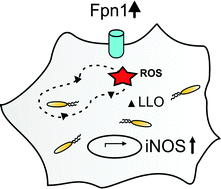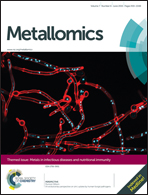Contrasting regulation of macrophage iron homeostasis in response to infection with Listeria monocytogenes depending on localization of bacteria
Abstract
Due to its multiple roles for the proliferation and pathogenicity of many microbes on the one hand and via modulation of immune effector functions on the other hand the control over iron homeostasis is thought to play a decisive role in the course of infections. Diversion of cellular iron traffic is considered as an important defense mechanism of macrophages to reduce metal availability for intracellular bacteria residing in the phagosome. However, evidence is lacking whether such alterations of iron homeostasis also become evident upon infection with bacteria gaining access to the cytosol like Listeria monocytogenes. Here we show that infection of macrophages with L. monocytogenes triggers the expression of the major cellular iron exporter ferroportin1 and induces cellular iron egress. As the growth of Listeria within macrophages is promoted by iron, stimulation of ferroportin1 functionality limits the availability of the metal for Listeria residing in the cytoplasm, whereas ferroportin1 degradation upon hepcidin treatment increases intracellular bacterial growth. In parallel to an increase of ferroportin1 expression, infected macrophages induce anti-microbial immune effector mechanisms such as TNFα formation or NO expression which are aggravated upon iron deficiency. These adaptive changes of iron homeostasis and immune response pathways are only found in macrophages infected with Listeria which express listeriolysin O and are therefore able to escape from the phagosome to the cytoplasm. Listeriolysin O deficient Listeria which are restricted to the phagosome are even killed by excess iron which may be based on “iron intoxification” via macrophage radical formation, because iron supplementation in that setting is paralleled by increased ROS formation. Our results indicate that ferroportin1 mediated iron export is a nutritional immune effector pathway to control infection with Listeria residing in the cytoplasm, whereas a different strategy is observed in mutant Listeria restricted to the phagosome, where iron remains in the macrophages likewise contributing to ROS mediated intoxification of bacteria.

- This article is part of the themed collection: Metals in infectious diseases and nutritional immunity

 Please wait while we load your content...
Please wait while we load your content...